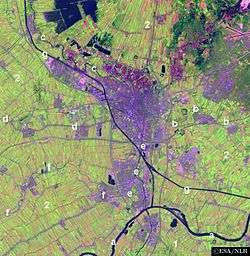Oude Rijn (Utrecht and South Holland)
The Oude Rijn (Old Rhine) is a branch of the Rhine delta in the Dutch provinces of Utrecht and South Holland. Its present-day length is 52 kilometres.
- For the Oude Rijn branch in Gelderland Province, see: Oude Rijn (Gelderland).
| Oude Rijn Old Rhine | |
|---|---|
 The Oude Rijn in Leiden. | |
Location of Oude Rijn in dark blue. | |
| Location | |
| Country | Netherlands |
| Region | Utrecht, South Holland |
| Physical characteristics | |
| Source | Leidse Rijn |
| • location | Harmelen, Utrecht |
| • coordinates | 52°05′31.5″N 4°57′48.5″E |
| Mouth | North Sea |
• location | Katwijk, South Holland |
• coordinates | 52°12′43″N 4°23′54″E |
| Length | 52 km (32 mi) |
In Roman times, it was the main Rhine branch, forming the northern border of the Roman Empire. In medieval times, it was used for river transport and there is a towpath along large sections of the river, many parts of which have been upgraded to roads over time. The river silted up in the course of the Middle Ages and had lost all of its importance by the 17th century.
Description
The city of Utrecht was founded at a ford near the fork of river Kromme Rijn into the Vecht to the north, and the Oude Rijn to the west. Of the original fork, little remains today and both Vecht and Rijn start from the city moat. For the first few kilometres of its course, the river is channelised and known as Leidse Rijn (Leiden Rhine). It becomes the Oude Rijn after the railway bridge near Harmelen (municipality Woerden). Then it flows westward through Woerden where first the river Lange Linschoten branches off to the south and then the Oude Rijn forms part of the city moats.
After Woerden, the river Grecht branches off to the north and the Oude Rijn continues through the towns of Nieuwerbrug, Bodegraven, and Zwammerdam. Here the river De Meije ends into the Oude Rijn. In Alphen aan den Rijn, the Aar Canal ends in the Oude Rijn at the same location where the river Gouwe branches off to the south. It flows then along Koudekerk aan den Rijn and Hazerswoude-Rijndijk (both part of the municipality of Rijnwoude).
After Zoeterwoude-Rijndijk and Leiderdorp (where the short river Does ends), the Oude Rijn flows through Leiden. Here starts the Rhine-Schie Canal (to the south) and the stream Zijl (to the north). The Nieuwe Rijn (New Rhine) is a short branch that together with the Oude Rijn are part of Leiden's moat system and both branches merge in the city's centre.
The stream Korte Vliet discharges into the Oude Rijn and it continues through Valkenburg and Rijnsburg to Katwijk. At Katwijk aan den Rijn the oegstgeesterkanaal merges with the Oude Rijn. From here the river has been straightened into a canal (also called Uitwateringkanaal) and ends into the North Sea through a pumping station, preventing high tides inland and silting up of the river mouth.
Roman era
In Roman times, the river Oude Rijn, which was much wider, formed part of the Roman Empire's northern border (Limes Germanicus). Many of the border-guarding castella and castra along the river evolved into cities and villages, including: Laurum (Woerden), Nigrum Pullum (Zwammerdam), Albaniana (Alphen aan den Rijn), Matilo (Leiderdorp), Praetorium Agrippinae (Valkenburg), and Lugdunum Batavorum (Katwijk).
In Valkenburg, the layout of the Roman castellum has been marked in the pavement.
 Satellite close-up of the Utrecht region showing the Leidse Rijn-Oude Rijn stream (d).
Satellite close-up of the Utrecht region showing the Leidse Rijn-Oude Rijn stream (d). Houses on the Oude Rijn near Alphen aan den Rijn
Houses on the Oude Rijn near Alphen aan den Rijn- Oude Rijn, Katwijk, a half mile before it ends: (A Pumping station to pump water into sea preventing high water levels inland.)
External links
